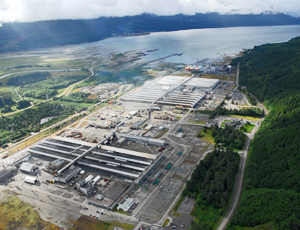
Montreal-based Rio Tinto Alcan’s plan to invest $2.5 billion in a new aluminum smelter in northwestern British Columbia has created a stir among engineering and construction contractors in the region. Last month, 300 local contractors attended a meeting in Vancouver, where plans to rebuild the existing Kitimat plant were presented.
Built in the 1950s and powered by the nearby Kemano generating station, the Kitimat plant is undergoing $300 million of preliminary work this year. The work includes a contractor village, cleaning and demolition of pot lines and the building of an underground utilities corridor to provide services to the new facility.
Rio Tinto Alcan’s vice president of British Columbia operations, Paul Henning, says once the new plant and modern smelting technology are up and running, the plant’s production capacity of 280,000 tons of aluminum a year will nearly double to 420,000 tons a year “while halving the environmental footprint that we have today.” Henning adds, “We will also be one of the lowest-cost operations for sure in the Rio Tinto fleet but probably [within] the smelter world [as well].” The plant will have the smallest environmental footprint of any of the company’s plants, he claims.
Lapointe Engineering of Kitimat is one of several firms working on the early stages of the project and is equally excited about Rio Tinto’s plan to move forward. In addition to building a new 1,000-sq-ft office, Lapointe has increased its technical staff to 37 from about 25, with plans to beef up its ranks even more to meet the added workload. Hiring more staff “is the only way we can do it,” according to the owner, Robin Lapointe.
“We can’t sustain all the jobs here,” Lapointe says. “But what we can do is have sub-consultant representatives on-site and funnel that work back to their offices. It’s our way of providing quality control. I’m hopeful that we can have five or six resident engineers on-site from other consulting firms.”
“Is there a lot of buzz in the area?” asks construction manager Mark Harnadek at 101 Industries Ltd. across town. “Absolutely. And is the money flowing? Yes, it is.” Harnadek expects bid packages for the $2.5-billion project—“the big stuff”—to roll out as early as the end of this year’s third quarter. And 101 Industries hopes to be right there in the thick of construction activities.
“One of the major components that’s needed would be a scrubber system to catch contaminated gas. It goes through a cycloning process and cleaning. Well, that whole system needs blow pipe, it needs structural-steel framing to hold everything up, it needs cladded roof systems—that’s where we come in,” Harnadek says.
Someone else keeping a close watch on developments in Kitimat is provincial Jobs, Tourism and Innovation Minister Pat Bell. He calls Rio Tinto’s decision to move forward with the multibillion dollar project “a significant turnaround for the northwest corner of the province” and “the first of many major projects that will be taking place in the region.” His ministry’s task has been to create a team to help Rio Tinto through a difficult permitting and approvals process.
“That’s been really key on a complex project of this nature. There are so many different sorts of permits that are necessary. To have a coordinated team delivering them, I think, is an approach we can replicate in other major projects,” says Bell.
The project still needs the go-ahead from Rio Tinto Alcan’s board of directors, something Paul Henning says is on the board’s agenda later this year. One of the biggest factors in the board’s decision will be the current North American price for aluminum on the London Metal Exchange, which Henning says is “great” at about “$2,500 a tonne, plus or minus a couple of hundred dollars.” Another factor, he adds, is the aluminum smelter’s location.
“We’re in an absolutely wonderful geographical position. We sit on the Douglas Channel, which is ice-free year-round, with full access to the open Pacific. That gives us the ability to bring in bulk raw materials from all over the Rio Tinto system,” says Henning.


Post a comment to this article
Report Abusive Comment